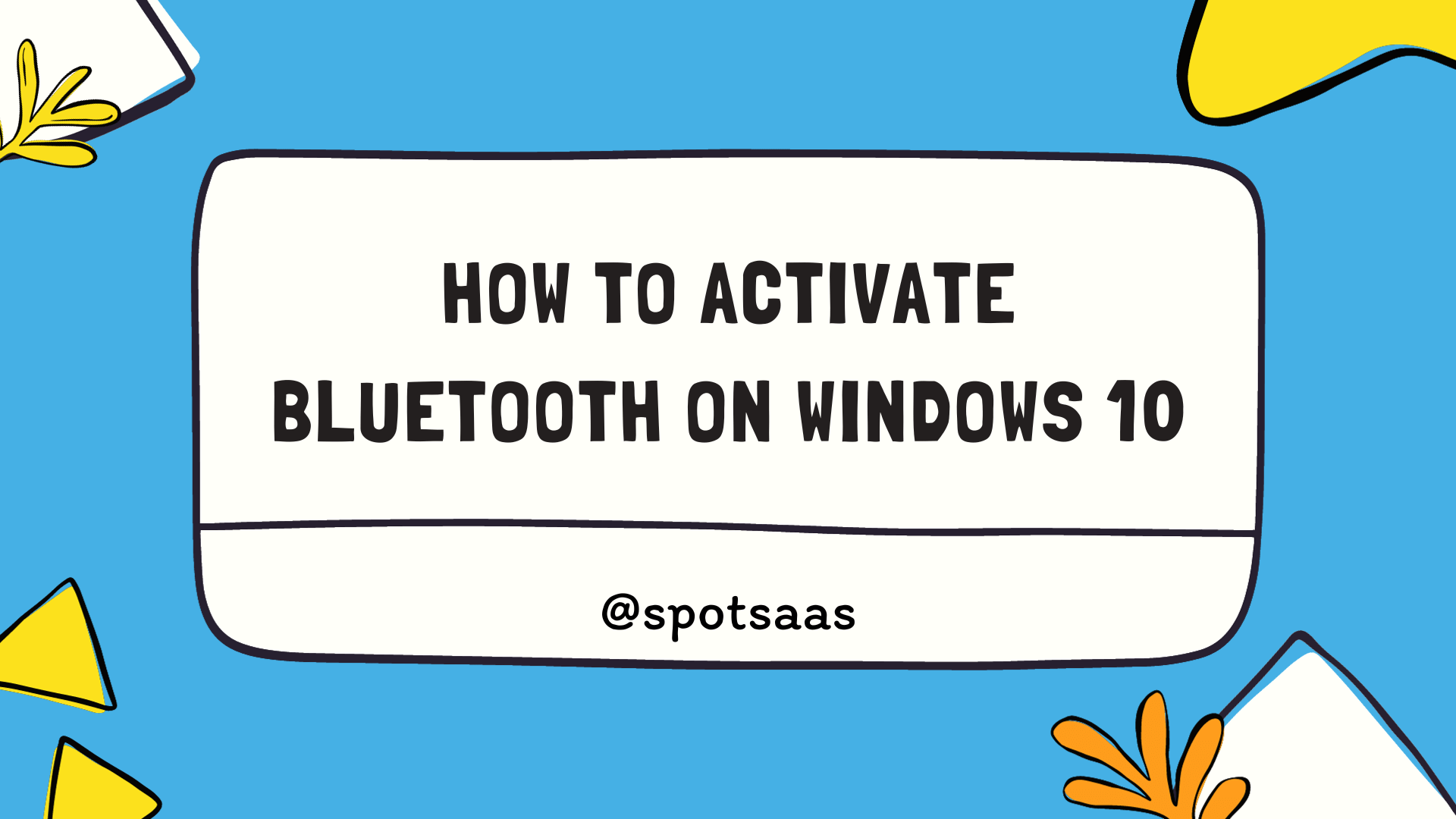Ever found yourself at odds trying to switch on Bluetooth on Windows 10 computer? Trust me, you’re part of a pretty large club. Recently cornered by this same issue, I swapped my distress call for a deep dive into the world of research and surfaced with an easy-to-follow roadmap to guide you through activating and pairing Bluetooth devices on your PC.
This blog post will serve as your personal tech guru, offering clear instructions along with tips to troubleshoot common hitches that might crop up during the journey. So let’s roll up our sleeves and make technology bend to our will, shall we?.
Key Takeaways
- Activating Bluetooth on Windows 10 can be done through the Start Menu or Settings.
- To pair a Bluetooth device, you can use Swift Pair or navigate to the Devices settings.
- Troubleshooting Bluetooth connection issues involves resetting the device, checking for compatibility, and ensuring it is within range.
- Additional tips include checking for USB interference and removing and re-adding Bluetooth devices.
How to Turn on Bluetooth on Windows 10
To turn on Bluetooth on Windows 10, there are two methods you can use – through the Start Menu or via the Settings.
Via Start Menu
To activate Bluetooth on Windows 10 via the start menu, we’ll walk through a straightforward process.
- First, I click on the Start button located at the lower-left corner of my screen.
- Next, I navigate to “Settings,” which is a gear-like icon in the sidebar.
- Once inside settings, I click on “Devices.”
- Now, I’ve entered the Devices settings; here on the left panel appears “Bluetooth and other devices.”
- Clicking this option brings up all Bluetooth settings.
- Lastly, if my Bluetooth is off, I simply toggle it ‘on’ with a quick click.
Through Settings
Initiate Bluetooth activation on Windows 10 effortlessly through the computer’s settings. Here’s how:
- Navigate to the lower left corner of your screen and click on the “Windows” icon.
- Select “Settings” from the menu that pops up.
- Look for “Devices”. Once you find it, click on it.
- Under “Devices”, you’ll see a tab named “Bluetooth & other devices”. Go ahead and select this tab.
- Now, look for the option that says “Bluetooth”. Right beside it, there should be a button which might be toggled off.
- Simply toggle this button to “On”.
- This instantly activates your Bluetooth.
How to Pair a Bluetooth Device on Windows 10
To pair a Bluetooth device on Windows 10, you can either use the Swift Pair feature or navigate to the Devices settings and manually connect your device.
Using Swift Pair
Swift Pair is a quick and convenient way to pair your Bluetooth devices with Windows 10. Here’s how you can do it:
- Activate Swift Pair by going to “Bluetooth & Other Devices” in the Settings.
- Turn on the device you want to pair, and make sure it’s discoverable.
- Wait for a notification to appear on your Windows 10 screen.
- Click on the notification, then select “Connect”.
- Follow any extra steps that might display on-screen.
Using the Devices Settings
To pair a Bluetooth device on Windows 10, you can also use the device’s settings. Here are the steps:
- Go to the Start menu and click on “Settings” (or press the Windows key + I).
- In the Settings window, select “Devices.”
- On the left-hand side, choose “Bluetooth & other devices.”
- Make sure the toggle switch under “Bluetooth” is turned on.
- Click on “Add Bluetooth or other device.”
- Select “Bluetooth” from the options presented.
- Ensure that your Bluetooth device is in pairing mode and discoverable.
- Windows will search for available Bluetooth devices and display them in a list.
- Click on your device’s name when it appears in the list.
- Follow any further prompts or instructions to complete the pairing process.
Thought you might like: How to Change Icon Size on Windows 10 in 2023.
Troubleshooting Bluetooth Connection
To troubleshoot Bluetooth connection issues on Windows 10, try resetting the Bluetooth device, checking for compatibility, and ensuring that the device is within range.
Resetting the Bluetooth device
To troubleshoot Bluetooth connection issues on Windows 10, you can try resetting the Bluetooth device. Here’s how:
- Turn off the Bluetooth device.
- On your Windows 10 computer, go to the Start menu and open the Settings app.
- Click on “Devices” in the settings menu.
- Select “Bluetooth & other devices” from the left-hand sidebar.
- Scroll down to the “Mouse, keyboard, & pen” section and click on the device that you want to reset.
- Click on “Remove device” and confirm your decision if prompted.
- Once the device is removed, turn it back on and put it into pairing mode (refer to your device’s manual for instructions).
- Go back to the Bluetooth settings on your Windows 10 computer and click on “Add Bluetooth or other devices.”
- Follow the prompts to re-pair your Bluetooth device with Windows 10.
Checking for compatibility
To ensure a smooth Bluetooth connection on Windows 10, it is essential to check for compatibility. Here are some important things to consider:
- Verify that your Bluetooth device is compatible with Windows 10.
- Ensure that your device has the necessary drivers installed for Windows 10 compatibility.
- Check if your Windows 10 system meets the minimum requirements for Bluetooth functionality.
- If you are using an older Bluetooth device, make sure it supports the version of Bluetooth supported by Windows 10.
- Consider checking the manufacturer’s website or user manual for any specific compatibility information.
Ensuring the device is within range
To ensure a successful Bluetooth connection, it is important to make sure that your device is within range. Here are some key steps to follow:
| Step | Guidance |
|---|---|
| Check the Distance | Ensure devices are within the recommended range (approx. 30 feet or 10 meters). |
| Remove Obstacles | Place devices in open spaces, minimizing obstructions like walls or furniture. |
| Avoid Interference | Avoid positioning Bluetooth devices near electronics or potential interference sources. |
| Stay Close Initially | Keep devices close during the initial pairing process to establish a strong connection. |
Additional Tips and Fixes
– Check for USB interference by disconnecting any unnecessary USB devices and see if that improves the Bluetooth connection.
– If you’re still having issues, try removing and re-adding the Bluetooth device to refresh the connection.
– Frequently asked questions about common Bluetooth problems and solutions are provided for easy troubleshooting.
Checking for USB interference
To ensure a smooth Bluetooth connection on your Windows 10 device, it is important to check for any USB interference. Follow these steps to address this issue:
| Step | Action |
|---|---|
| Disconnect USB Devices | Unplug all external USB devices connected to your computer. |
| Move Bluetooth Device | Keep the Bluetooth device away from USB ports to minimize interference. |
| Try Different USB Ports | For Bluetooth adapters, test different USB ports to identify the one with the least interference. |
| Use USB Extension Cable | Employ a USB extension cable to separate the Bluetooth device from potential sources of interference. |
Removing and re-adding Bluetooth device
To remove and re-add a Bluetooth device on Windows 10, follow these simple steps:
- Go to the “Bluetooth & Other Devices” section in the Windows 10 settings.
- Select the device you want to remove.
- Click on the “Remove Device” button.
- Confirm the removal by clicking “Yes.”
- Once removed, turn off the Bluetooth device.
- Wait for a few seconds and then turn it back on.
- Go back to the “Bluetooth & Other Devices” section in settings.
- Click on the “+ Add Bluetooth or Other Device” button.
- Choose “Bluetooth” from the list of options.
- Follow any further instructions to complete the pairing process.
Common FAQs
I receive many questions about Bluetooth activation on Windows 10. One common question is, “How do I know if my Bluetooth device is discoverable?” To make your device discoverable, you usually need to press and hold a button or switch on the device itself.
Another frequently asked question is, “Why can’t I see the ‘Start’ option in my Bluetooth settings?” In this case, you can try restarting the Bluetooth Support Service by following these steps: Press the Windows key + R to open the Run dialog box, type services.msc and press Enter.
Scroll down and locate “Bluetooth Support Service,” right-click it and select Restart. These FAQs cover some of the common issues users encounter when activating Bluetooth on Windows 10.
Conclusion
In conclusion, activating Bluetooth on Windows 10 is a straightforward process that can greatly enhance your device connectivity. By following the step-by-step guide outlined in this article, you’ll be able to turn on Bluetooth, pair devices, and troubleshoot any connection issues with ease.
With Bluetooth enabled on your Windows 10 device, you’ll have the freedom to connect and enjoy a wide range of wireless accessories and peripherals hassle-free. So go ahead and activate Bluetooth today for a more convenient and seamless computing experience.
FAQs
1. How do I activate Bluetooth on Windows 10?
To activate Bluetooth on Windows 10, go to the Start menu, open Settings, select Devices, and toggle the switch under “Bluetooth & other devices” to On.
2. What if I can’t find the Bluetooth option in my Windows 10 settings?
If you can’t find the Bluetooth option in your Windows 10 settings, it means your device might not have a built-in Bluetooth capability. You can use an external USB Bluetooth adapter to enable Bluetooth connectivity.
3. Can I connect multiple devices via Bluetooth on Windows 10?
Yes, you can connect multiple devices via Bluetooth on Windows 10 as long as they are within range and compatible with your device’s version of Bluetooth.
4. How do I pair a device with my computer using Bluetooth?
To pair a device with your computer using Bluetooth, make sure both devices are discoverable and turn on their respective pairing modes. Then, select “Add Bluetooth or other device” from the Settings menu, choose the appropriate device category (e.g., headphones), and follow the on-screen instructions to complete the pairing process.
5. How do I troubleshoot common issues with Bluetooth on Windows 10?
To troubleshoot common issues with bluetooth connectivity on windows ten you may check for software updates related to your bluetooth driver which might resolve any conflicts that could be causing problems




